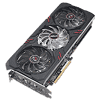 37
37
ASRock Radeon RX 6600 XT Phantom Gaming D Review - Best Overclocker, Best Cooler
Cooler Performance Comparison »Temperatures
| Temperature & Noise Comparison | ||||||||
|---|---|---|---|---|---|---|---|---|
| Idle | Gaming | |||||||
| GPU | Noise | GPU | Hotspot | Noise | RPM | |||
| ASRock RX 6600 XT Phantom Gaming | 38°C | Fan Stop | 61°C | 80°C | 29.1 dBA | 1438 RPM | ||
| ASUS RX 6600 XT STRIX OC | 44°C | Fan Stop | 59°C | 81°C | 41.2 dBA | 2000 RPM | ||
| ASUS RX 6600 XT STRIX OC (Quiet BIOS) | 43°C | Fan Stop | 65°C | 87°C | 34.4 dBA | 1565 RPM | ||
| MSI RX 6600 XT Gaming X | 42°C | Fan Stop | 66°C | 93°C | 30.0 dBA | 1566 RPM | ||
| Sapphire RX 6600 XT Pulse | 42°C | Fan Stop | 70°C | 97°C | 27.9 dBA | 1739 RPM | ||
| XFX RX 6600 XT Merc 308 | 41°C | Fan Stop | 75°C | 98°C | 24.5 dBA | 1293 RPM | ||
Thermal Analysis
For this test, we first let the card sit idle to reach thermal equilibrium. Next, we start a constant 100% gaming load, recording several important parameters while the test is running. This shows you the thermal behavior of the card and how the fans ramp up as temperatures increase. Once temperatures are stable (no increase for two minutes), we stop the load and record how the card cools down over time.
Fan Noise


Apr 25th, 2024 21:20 EDT
change timezone
Latest GPU Drivers
New Forum Posts
- TPU's Nostalgic Hardware Club (18465)
- Post your Speedometer 3.0 Score (36)
- Size on Disk Excessively Different than Size (9)
- Dell Workstation Owners Club (3056)
- Core PL1 + GPU PL1 + Ring EDP OTHER (10)
- Best SSD for system drive (80)
- Which new games will you be buying? (315)
- BSOD if I touch the pcache offset voltage in throttlestop (i9-13900hx lenovo pro 7i) (23)
- Alphacool CORE 1 CPU block - bulging with danger of splitting? (16)
- How to check flatness of CPUs and coolers - INK and OPTICAL INTERFERENCE methods (112)
Popular Reviews
- Fractal Design Terra Review
- Thermalright Phantom Spirit 120 EVO Review
- Corsair 2000D Airflow Review
- ASUS GeForce RTX 4090 STRIX OC Review
- NVIDIA GeForce RTX 4090 Founders Edition Review - Impressive Performance
- ASUS GeForce RTX 4090 Matrix Platinum Review - The RTX 4090 Ti
- MSI GeForce RTX 4090 Suprim X Review
- Gigabyte GeForce RTX 4090 Gaming OC Review
- MSI GeForce RTX 4090 Gaming X Trio Review
- MSI GeForce RTX 4090 Suprim Liquid X Review
Controversial News Posts
- Sony PlayStation 5 Pro Specifications Confirmed, Console Arrives Before Holidays (117)
- Windows 11 Now Officially Adware as Microsoft Embeds Ads in the Start Menu (107)
- NVIDIA Points Intel Raptor Lake CPU Users to Get Help from Intel Amid System Instability Issues (106)
- AMD "Strix Halo" Zen 5 Mobile Processor Pictured: Chiplet-based, Uses 256-bit LPDDR5X (101)
- US Government Wants Nuclear Plants to Offload AI Data Center Expansion (98)
- AMD's RDNA 4 GPUs Could Stick with 18 Gbps GDDR6 Memory (88)
- Developers of Outpost Infinity Siege Recommend Underclocking i9-13900K and i9-14900K for Stability on Machines with RTX 4090 (85)
- Windows 10 Security Updates to Cost $61 After 2025, $427 by 2028 (84)